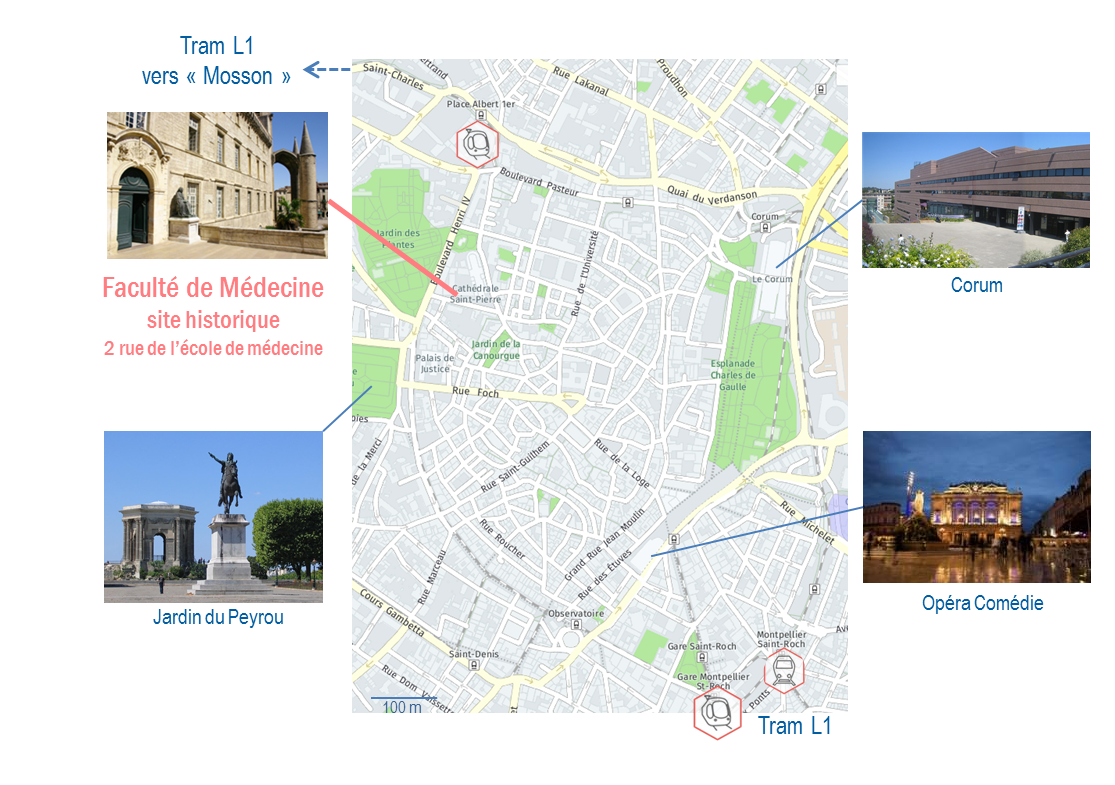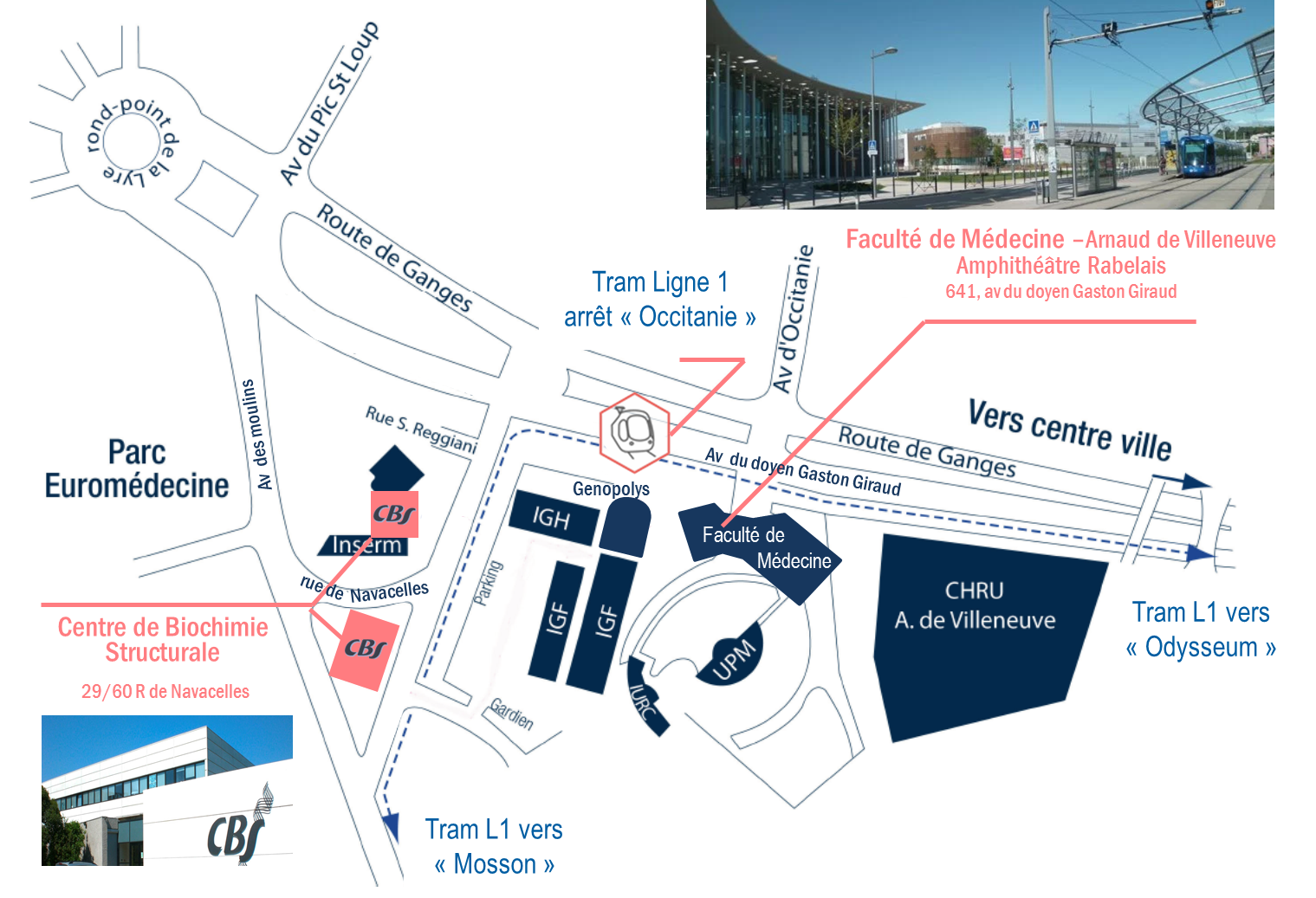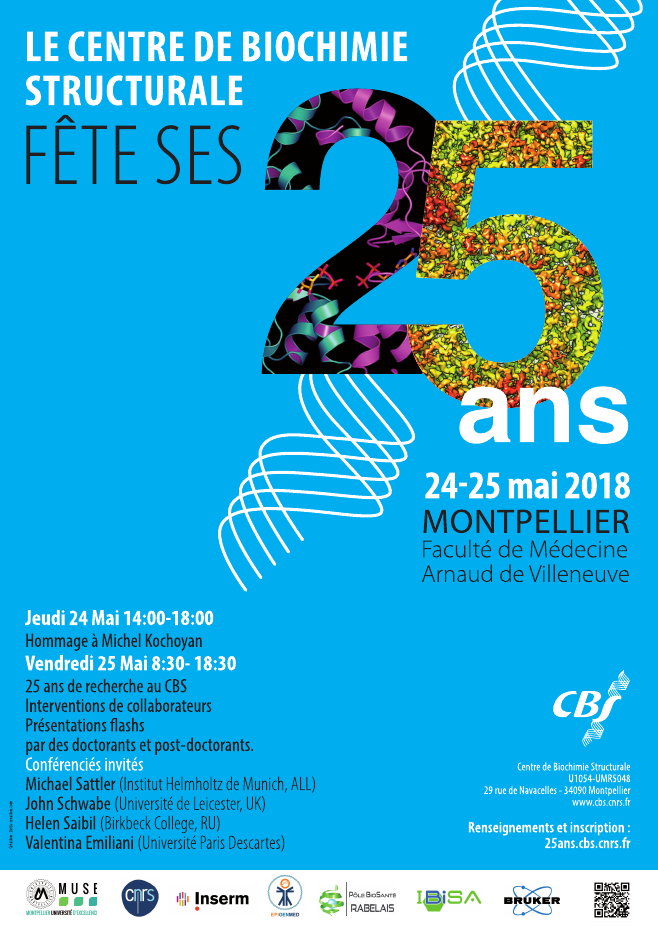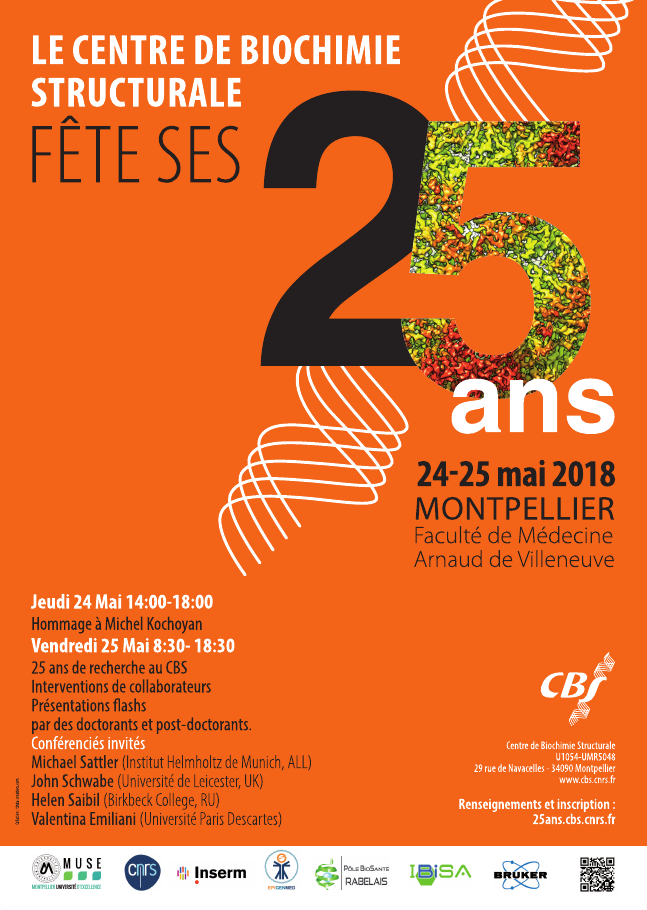Programme
The event will take place from Thursday, May 24 2018 to Friday May 25, 2018
Registration is free but mandatory (25ans.cbs.cnrs.fr/inscription). The conference will be held at the Rabelais amphitheater in the new Faculty of Medicine Arnaud de Villeneuve.
The first half-day will be dedicated to a tribute to Michel Kochoyan, former director of the CBS and involved in many national structures, sadly missing in May 2016. The day will end with an aperitif-dinner that will be served in the honor courtyard in the historic site of the Faculty of Medecine.
An overview of the research conducted at the CBS for 25 years will be given during the following day. During this day alternate lectures in the main areas of research of the CBS, contributions of collaborators and former members of the CBS, and the presentation of posters by doctoral and post-doctoral students.
Visits of the laboratory facilities including structural biology and microscopy platforms will be organized during both days. Participation in one of these visits is proposed in the registration form.
Thursday, May 24th 2018
|
|
|
14:00-17:20 TRIBUTE TO MICHEL KOCHOYAN (New Faculty of Medicine, Arnaud de Villeneuve)
14:00-14:20 Cathy Royer (former CBS Director; RPI, USA)
14:20-15:30 Speeches by Frédéric Dardel (University Paris-Descartes), Erick Dufourc (CNRS, Paris), Bruno Robert (Saclay), Joël Bockaert (Montpellier)
15:30-16:10 Coffee break
16:10-17:20
Tony Wilkinson (York University, UK) "Switching on a Phosphatase to Promote Cell Differentiation",
Herman van Tilbeurgh (University Paris-Saclay) "The essential t6A tRNA modification in the three kingdoms of life",
Sylvie Rimsky (Collège de France, Paris) & Stefan Arold (Kaust, KSA) "H-NS: a multi-structured drama in 5 acts.".
17:30-18:30 Visit of CBS platforms (groups #1, #2 and #3)
|
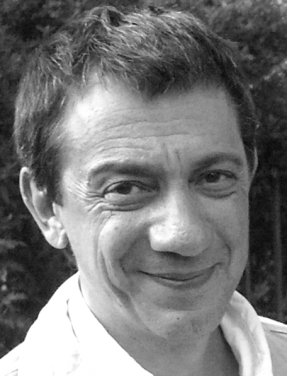
|
|
19:30-23:00 BANQUET (with invitation - Faculty of Medicine, historical center)
Animation by the group "Les Grandes Gigues", traditional and world music.
|
Friday, May 25th 2018
|
8:30-12:30 25 YEARS OF RESEARCH AT THE CBS (New Faculty of Medecine)
8:30-9:00 Speeches by Pierre-Emmanuel Milhiet (CBS director) and representative members of tutelary institutions
9:00-9:40 Michael Sattler (Helmholtz Institute, Munich, Germany) "Decoding regulatory protein-RNA interactions by combining NMR and integrative structural biology"
9:40-10:00 Jean-Philippe Pin (IGF, Montpellier) "GPCR dynamics, what the glutamate receptors tell us"
10:00-10:30 « My poster in 1 min »
10:30-11:10 Coffee break / Poster session
|
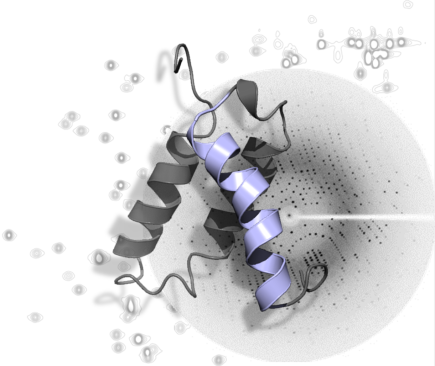
|
|
11:10-11:50 John Schwabe (University of Leicester, UK) "The machinery of transcriptional repression... and resulting disease when things go wrong..."
11:50-12:10 Guillaume Drin (IPMC University, Nice) "3SPW : a key millestone to reveal new lipids exchange routes in the cell"
12:10-12:30 Marylène Mougel (IRIM, Montpellier) "Imaging the late steps in HIV-1 life cycle"
|
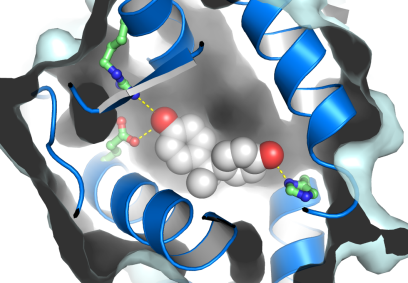
|
|
13:30-14:20 Visit of CBS platforms (groups #4 and #5)
|
|
14:30-15:10 Helen Saibil (Birkbeck College, UK) "Electron microscopy studies of protein aggregation and disaggregation"
15:10-15:30 Daniel Levy (Institut Curie, Paris) "The secret story of in vitro reconstitution of the tetraspanin web at the CBS"
15:30-15:50 Rachel Cerdan (DIMNP, Montpellier) "Structural and functional characterization of Plasmodium CTP:phosphocholine cytidylyltransferase, a key enzyme of malaria lipid biosynthesis"
15:50-16:20 « My poster in 1 min »
16:20-17:00 Coffee break/ Poster session
|
|
16:50-17:40 Valentina Emiliani (University Paris-Descartes) "Toward circuits optogenetics"
17:40-18:00 Giacomo Cavalli (IGH, Montpellier) "The role of Polycomb proteins and 3D genome organization in epigenetic regulation of development"
18:00-18:20 Silvia Zorrilla (CSIC, Madrid, Spain) "Mechanisms of essential bacterial regulatory processes enlightened by fluorescence"
|
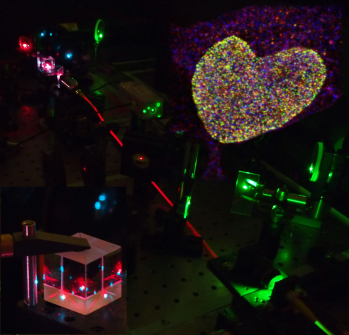
|
|
18:20-18:30 Concluding remarks
|
Posters
#1 A catch-bond drives stator mechanosensitivity in the bacterial flagellar motor. AL Nord, E Gachon, R Perrez-Carrasco, JA Nirody, A Barducci, RM Berry, F Pedaci
#2 The contribution of cytoskeleton in (spontaneous curvature)-driven poration of red blood cells. L Dumas, C Braun-Breton, M Abkarian
#3 A novel approach to enable the structural and dynamics characterisation of glutamine homorepeats. A Urbanek, A Morató, M Popovic, F Allemand, A Fournet, E Delaforge, S Delbecq, N Sibille, P Bernadó
#4 A coarse-grained modeling approach for investigating nuclear receptors regulation. R Bailly, M Paloni, A Barducci
#5 Accurate models of intrinsically disordered proteins using a structure-encoding coil database. A Estaña, N Sibille, E Delaforge, M Vaisset, J Cortés, P Bernadó
#6 Adventurous motility of Myxococcus xanthus on the single cell and population level. S Rombouts, J-B Fiche, L Costa, P-E Milhiet, T Mignot, M Nöllmann
#7 An efficient cell-free strategy to produce stable huntingtin for structural studies. A Morató, A Urbanek, F Allemand, A Fournet, E Delaforge, S Delbecq, N Sibille, P Bernadó
#8 Cell free biosensors for cortisol and kynurenine testing: towards their use in psychiatric population. I Conejero, P Courtet, J Bonnet
#9 Characterization of promoters dynamic range for Integrase expression in E. coli. M Camacho, A Zúñiga, S Guiziou J Bonnet
#10 Engineering yeast-based Bbiosensors. M. Meunier, A. Zúñiga, J. Bonnet.
#11 Chromatin spatial organization at the intra-TAD level. J Gurgo, D Cattoni, C Houbron, JB Fiche, O Messina, G Cavalli
#12 DNA Origami for molecular self-assembly. N Aissaoui, A Mills, G Bellot
#13 FRET-AFM: A novel microscope combining single molecule fluorescence and interaction forces at nanoscale. O. Saavedra, L. Costa, E. Margeat and P-E Milhiet
#14 High-resolution analysis of poly-proline homorepeats in huntingtin protein. M Popovic, A Urbanek, A Morató, F Allemand, A Fournet, E Delaforge, S Delbecq, N Sibille, P Bernadó
#15 Imaging chromatin organization during Drosophila embryonic development using multiplex DNA labelling. S Espinola, A Cardozo Gizzi, O Messina, F Berard, C Houbron, JB Fiche, M Lagha, D Cattoni, M Nöllmann
#16 Implementation of integrase-based logic circuits in living organisms. S Guiziou, A. Zúñiga, P Mayonove, F Ullinia, V Moreau, M Leclere, J Bonnet
#17 Improving ligand screening by exploiting structure ensembles and machine learning. M Schneider, J-L Pons, W Bourguet, G Labesse
#18 Synthetic receptor platform for the design of signal-transducing linkers in artificial membrane receptors. HJ Chang, J Gracy, P Mayonove, L Ciandrini, M Cohen-Gonsaud, G Cambray, J Bonnet
#19 Insights into substrate and inhibitor selectivity among human glucose transporters through comparative modeling and molecular docking. R Ferreira, JL Pons, G Labesse
#20 Membrane remodelling during interphase nuclear pore complex assembly. A Vial, PE Milhiet, C Doucet
#21 Multiscale molecular modeling of cellular condensates. M Paloni, R Bailly, A Barducci
#22 Plasmid and chromosome segregation are coordinated. B Guilhas, A Le Gall, JB Fiche, J Rech, JY Bouet, M Nöllmann
#23 Self-assembly of nanostructures from ten thousand unique components. A Mills, LL Ong, Y Ke, P Yin, G Bellot
#24 Single molecule measurements of E. coli transcription-termination factor Rho helicase, and its interaction with RNA polymerase. RK Vishwakarma, A Nord, F Pedaci, M Boudvillain, E Margeat
#25 3D Stimulated Emission Depletion Microscopy for Imaging in whole Organisms. M Götz, A Le Gall, J-B Fiche, E Margeat, M Nöllmann
#26 Structural characterization of vasopressin V2 recepor in complex with Gs protein by cryo-electron microscopy. J Bous, A Ancelin, J Lai Kee Him, H Orcel, R Healey, S Granier, B Mouillac, P Bron
#27 Systematic optimization of cell-free transcription factor-based biosensors. P Voyvodic, A Pandi, J-L Faulon, J Bonnet
#28 Hemodynamic behavior of sickle cell red blood cells in glass capillaries: phenomenon of auto-margination. V Claveria, P Connes, L Lanotte, C Wagner, M Abkarian
#29 Chromosomal configuration studies on Bacillus subtilis cellular cycle. H Bononi, A Le Gall, M Nöllmann
#30 Designing of new enzymes for biosynthesis of xenobiotic nucleotide triphosphates. RM Rahimova, PA Kaminski, G Labesse
#31 Recognition of the Magnaporthe oryzae effectors AVR-Pia and AVR1-CO39 by the decoy domain of the rice NLR immune receptor RGA5. K de Guillen, S Cesari, L Guo, L Mammri, D Ortiz, J Liu, T Kroj, A Padilla
#32 SOS response activation in Escherichia coli by Mrr restriction endonuclease. A Bourges, OE Torres, A Ghosh, W Tadesse, G Labesse, N Declerck, A Aertsen, C Royer
#33 Structural study of the Mycobacterium RbpA protein: a master regulator of gene expression implicated in drug resistance. C Chevillard, J Lai Kee Him, A Ancelin, S Trapani, F Hoh, Z Morichaud, O Maskri, L Chaloin, JP Leonetti, K Brodolin, P Bron
#34 Relationships between Rho and RNA Polymerase in living bacteria. C Clerté, O Manier, M Soussi, JB Fiche, M Boudvillain, L Bossi, N Figueroa-Bossi, E Margeat
#35 Cryo Electron Microscopy study of the Caulimo-Mosaic Virus. A Ancelin, S Trapani, S Blanc, C Fallet, P Bron, F HoH, C Fallet, M Uzest, J Lai Kee Him
#37 PTS-mediated Activation of the antiterminator LicT as seen by methyl based liquid NMR. Y Yinshan, A Padilla, K de Guillen, L Mammri, J Gracy, N Declerck, H Déméné
#36 Elucidation of allosteric activation of LicT antiterminator as seen by NMR. Y Yinshan, A Padilla, K de Guillen, L Mammri, J Gracy, N Declerck, H Déméné
#37 Signalization of mu opoid receptor deciphered by liquid state NMR. R Sounier, I Stayert, T Learemans, C Mas, A Manglik, B Kobilka, W Huang, H Déméné, S Granier
Download the full program
